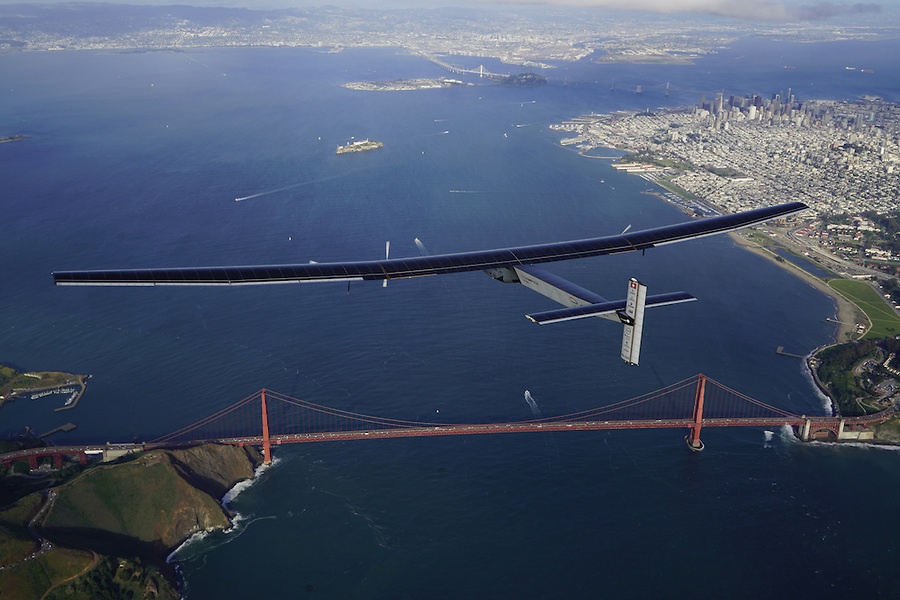
This week, advanced transportation was making headlines across the country… but this week it’s not just electric cars and charging infrastructure. The news was full of solar planes, storage trains, and automated automobiles, as well as some of those EVs we love (though not everyone is loving them). Read on for this week’s advanced energy news update.
Just before sunrise last Thursday, Solar Impulse 2, the plane powered entirely by AEE member Sunpower’s solar panels, took off from Hawaii in continuation of its around-the-world journey. It flew over the Golden Gate Bridge about 56 hours later. The plane had just had a 10-month stay in Hawaii to repair batteries, which were overtaxed by the flight from Japan to Hawaii. It landed safely at the Moffat Airfield in Mountain View, right in the heart of Silicon Valley.
The plane, which has 17,000 solar cells spread over wings the size of a jumbo jet in order to lift about the weight of a car, is not exactly ready for cargo shipping or long passenger flights. Just ask Wired Magazine. Their article, entitled, “What it’s like to fly in a plane with a coffin-sized cockpit,” points out that the plane is not exactly built for comfort. The toilet is literally built into the seat, for one thing. But that’s not the point of Solar Impulse 2. The solar plane represents a next step in aviation. The Wright Brothers’ first plane in Kitty Hawk didn’t have a bathroom at all, after all, and fewer than 60 years later we were shooting people into low-Earth orbit. We’ll be watching as the team finishes the trip around the world in the coming days and weeks, not least because the photos are just so striking.
From high in the sky to something a little more terrestrial: A California start-up is taking a mobile approach to energy storage: trains! Peter Maloney, writing for Utility Dive, explains how it would work: “Electricity powers an electric motor in a locomotive that hauls a heavy load up hill. Sitting at the top of the hill, the rail cars store energy. When the energy is needed, the cars are released to roll down hill and the electric motor runs in reverse to generate electricity.” It’s the same technology a Prius uses to charge its batteries.
Advanced Rail Energy Storage (ARES) hopes to begin construction in 2017 on a 50 MW test site in Nevada, but, CEO James Kelly points out, the trains will only get more efficient as they get larger. “If we had a 500 MW project, we could double the capacity and it would only increase capital costs by 20%,” he said. For now though, as Utility Dive points out, rail is not exactly a new technology, it’s a unique solution. “We control rail-based energy storage right now,” Kelly said.
In the world of advanced vehicles, we are finally finding that least rare of breeds: unhappy consumers. A few Tesla vehicles have been recalled for some software glitches, the frustration of which was outlined by Tesla Model X owner Byron Deeter. First his door wouldn’t open, then it wouldn’t close, then the emergency brake engaged without his activation. Although these incidents appear to be limited, it’s some of the first discontent we’ve heard from Tesla enthusiasts. Greentech Media, perhaps taking cues from Wired’s “coffin plane” headline, wrote a news round-up entitled, “If the Tesla Model X Rollout Is Any Indication, Autonomous Driving Is Going to Be a Bloodbath.” Hyperbole, much?
A quick aside: I know that “if it bleeds it leads,” but there are other ways to generate clicks. Secondly, a little realism, please. Even if we were suddenly in a dystopian Terminator/Transformers crossover robot apocalypse situation, could it be worse than what we have now with human drivers? In 2014 alone more than 32,600 people died in fatal crashes in the U.S., which is a number we’re apparently okay with. It’s enough for the CDC to call automotive accidents a “major cause of death in the U.S.” Optimus Prime and the Autobots are welcome on my road any day.
Which is not to say there wouldn’t be some pain if robots took over the wheel. TechCrunch published a story this week pointing out that the first automotive industry to go automated would undoubtedly be long-haul trucking, and that it would lead to millions of lost jobs for drivers. Shipping a full truckload cross-country costs approximately $4,500, with labor representing three-quarters of the cost. Plus, robots don’t need time off for such human needs as “sleep” or “food.”
Finally, last week, SunEdison filed for bankruptcy under Chapter 11. We were sorry to get the news about this AEE member company. Still, it is important to note that the news outlets that cover advanced energy most closely do not see SunEdison’s troubles as signs of a larger, industry-wide problem. GreenBiz published “Why SunEdison’s bankruptcy won’t deflate the solar boom.” Greentech Media cited BNEF’s Head of Solar, Jenny Chase, who said, “SunEdison’s bankruptcy says more about the company’s strategic decisions than about the solar industry as a whole.” In Fortune, Katie Fehrenbacher wrote, “SunEdison’s downfall isn’t rooted in the failure of solar and wind…. Companies in any industry—from drugs to mining to airlines—could, and have, met the same fate.”
Michael Kanellos, writing in Forbes, pointed out that SunEdison wasn’t the only energy company to file for bankruptcy: Peabody Coal and Chesapeake Energy fracking subsidiary Seventy Seven Energy also went Chapter 11 around the same time. “The uncomfortable fact is this,” Kanellos writes, “energy is an extremely painful business.” But, he continues, “the opportunity is tremendous.” Also worth noting that Chapter 11 allows the company to reorganize to preserve the business and pay creditors over an extended timeframe. Here’s hoping we get to see SunEdison rise again!
Get all the advanced energy news you need by signing up for AEE's weekly newsletter. Click below!
